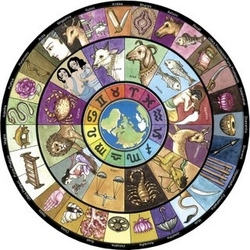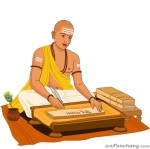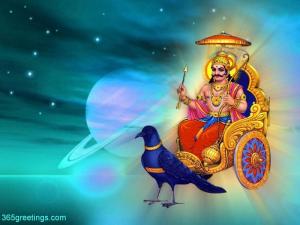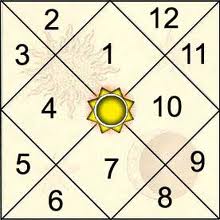
Credit: indiamart.com 12 zodiac signs surrounded by 27 Nakshatras (Asterisms) through which the moon passes each lunar day
India’s culture and civilization have always displayed an intriguing obsession with stellar phenomena. The Hindu infatuation with the movement of the planets, the Zodiac and the Asterisms is quite unique, deeply affecting social behaviour, religious observances, fasts and festivals, ritual and customs and even commercial and trading activities. More plausibly, it has also been the basis for determining the passage of time and fixing the duration of a day, a month and the year in the Hindu lunar calendar at a time when the benefits of modern time scales and calendars were not available in ancient India.
 While other cultures are not unfamiliar with astrology, there is a fundamental difference in the manner in which it is treated by other established religions. Generally it is viewed with suspicion if not hostility as a heterodox discipline at variance with religious dogma and therefore to be clubbed with heretical beliefs like witchcraft. In Hinduism, on the contrary, it is given unequivocal scriptural sanction, incorporating astrological practices within the very rituals of worship. Thus the planets themselves are included in the pantheon of deities and find a place in ritual worship, with some temples even being dedicated to them. It is therefore not surprising that Hindu clerics and the priesthood are required to be proficient in Astrology if they are to discharge their religious duties effectively. thus in India we find that the Pundit and the astrologer are more or less synonymous. This is not the case with priests of other religions.
While other cultures are not unfamiliar with astrology, there is a fundamental difference in the manner in which it is treated by other established religions. Generally it is viewed with suspicion if not hostility as a heterodox discipline at variance with religious dogma and therefore to be clubbed with heretical beliefs like witchcraft. In Hinduism, on the contrary, it is given unequivocal scriptural sanction, incorporating astrological practices within the very rituals of worship. Thus the planets themselves are included in the pantheon of deities and find a place in ritual worship, with some temples even being dedicated to them. It is therefore not surprising that Hindu clerics and the priesthood are required to be proficient in Astrology if they are to discharge their religious duties effectively. thus in India we find that the Pundit and the astrologer are more or less synonymous. This is not the case with priests of other religions.
The Hindu lunar calendar is in fact an exercise in Astronomy, providing forecasts in Almanacs meticulously accurate and prepared for every major city covering the zones in their vicinity, on a daily basis the precise time of sunrise and sunset and movements of the planets, Zodiacs and Asterisms ( Nakshatras) down to the minute. This becomes invaluable information for religious and social observances and ‘prohibitions’ for the lay man and the cleric.
Let us then take a peek into this India to see what happens on a daily basis in the lives of its denizens:
We begin at a traffic light where we have halted our vehicle when it turned red. A boy comes running up holding aloft what looks like a small stainless steel bucket full of mustard oil. Not the usual street urchin demanding alms so persistently. In the oil in the bucket sits a metal deity. The boy calls ‘Shani Dev Shani Dev’ ( Lord Saturn). As it is a saturday, Lord Saturn’s day, we are expected to drop some offering into the container to ward off inauspicious events waiting to happen to us in the course of the day. Lord Saturn is known popularly to cause many painful trials on his day ( for our evolution). We have just glimpsed a planet arriving at a traffic road light – close encounter on a busy Indian street on a quite ordinary day!
 Then again when looking for a spouse for your daughter you may discover that the prominence of Mars in her astrological chart makes her into what is called a ‘Mangli’ (Martian). A serious disqualification as it could result in the premature demise of a prospective spouse. Such an astrological chart sent for ‘matching’, a necessity in arranged Hindu marriages, gets promptly rejected unless the prospective groom is also a ‘Martian’ when the two defects cancel each other out. Another close encounter, this time with Mars in an Indian home.
Then again when looking for a spouse for your daughter you may discover that the prominence of Mars in her astrological chart makes her into what is called a ‘Mangli’ (Martian). A serious disqualification as it could result in the premature demise of a prospective spouse. Such an astrological chart sent for ‘matching’, a necessity in arranged Hindu marriages, gets promptly rejected unless the prospective groom is also a ‘Martian’ when the two defects cancel each other out. Another close encounter, this time with Mars in an Indian home.
On another quite ordinary day you irritably phone the contractor at your building site to esquire why the labourers, plumbers and electricians have failed to turn up. With some annoyance he retorts, ”don’t you know?” Know what? It is neither a weekend nor Sunday, no national holiday, no festival either, nothing? He explains with some exasperation, ”Sir, It is Amavasya – a No-Moon day which is inauspicious, a day on which labourers and handymen don’t work. They may work on weekends and Sundays even but not on Amavasya which occurs once a month without warning on any Georgian calendar – you better arm yourself with a lunar Hindu calendar. This time close encounter with the Moon on a work site!
 During lunar and solar eclipses all auspicious activity is suspended. There is no question of going out to watch the phenomenon through dark lenses, the family remain huddled indoors till it passes, particularly pregnant women. Evil forces are abroad then in the shape of the demons Rahu or Ketu ( titans who drank the cup of nectar but were cut asunder to prevent it having its effect of immortality reserved for the gods – Rahu now a bodyless head and Ketu a headless body) who, though astrologically only lunar nodes, are deemed to be planets in their own right capable of causing great harm. particularly when they ‘swallow the luminous heavenly bodies the Sun and the Moon during eclipses. After the eclipse, purification baths and fasts are in order to cleanse the body and spirit of the evil that has just passed; another close cosmic encounter.
During lunar and solar eclipses all auspicious activity is suspended. There is no question of going out to watch the phenomenon through dark lenses, the family remain huddled indoors till it passes, particularly pregnant women. Evil forces are abroad then in the shape of the demons Rahu or Ketu ( titans who drank the cup of nectar but were cut asunder to prevent it having its effect of immortality reserved for the gods – Rahu now a bodyless head and Ketu a headless body) who, though astrologically only lunar nodes, are deemed to be planets in their own right capable of causing great harm. particularly when they ‘swallow the luminous heavenly bodies the Sun and the Moon during eclipses. After the eclipse, purification baths and fasts are in order to cleanse the body and spirit of the evil that has just passed; another close cosmic encounter.
But cosmic events are not generally ominous. every full moon,( Purnima). important festivals and celebrations gladden the spirit. The birth of great personages like the Buddha and guru Nanak of the Sikh faith happen to fall on the full moon. However on the fourth day after No-moon one never looks at the misshapen planet for if you did a great misfortune like burglary would occur in ones home.
 Then you have the great religious gatherings or super pilgrimages at the confluence of certain rivers when millions from the four corners of the sub-continent congregate for a holy dip under a unique configuration of stars at a given moment at the great festival of Kumbh, to wash off sins and gain spiritual and material credit . This happens when the Sun the Moon and Jupiter arrive together in preordained constellations every twelve years. This commemorates the tussle for the pot of nectar, the Kumbh, which emerged from the celestial churning of the oceans by the gods and Titans. In the ensuing struggle some drops spilled onto the earth. these mythical spots become the centres of pilgrimage for millions of devotees. Aside from the pilgrims, retinues of mendicants and naked fakirs belonging to well established esoteric orders surviving over millenia in remote corners of India and the high Himalayas arrive on horseback, elephants and chariots, resplendent with spears, gleaming tridents, unsheathed swords and caste marks on their bodies and foreheads, for the holy dip. Some are stark naked on horseback, having shed all attributes of ego, including garments, others bejeweled in silken robes of saffron and white, yet others, as a mark of containing their passions are known to walk with their phalli bandaged and tied to their wastes. It is a sight from pre-history and attracts foreign tourists in droves.
Then you have the great religious gatherings or super pilgrimages at the confluence of certain rivers when millions from the four corners of the sub-continent congregate for a holy dip under a unique configuration of stars at a given moment at the great festival of Kumbh, to wash off sins and gain spiritual and material credit . This happens when the Sun the Moon and Jupiter arrive together in preordained constellations every twelve years. This commemorates the tussle for the pot of nectar, the Kumbh, which emerged from the celestial churning of the oceans by the gods and Titans. In the ensuing struggle some drops spilled onto the earth. these mythical spots become the centres of pilgrimage for millions of devotees. Aside from the pilgrims, retinues of mendicants and naked fakirs belonging to well established esoteric orders surviving over millenia in remote corners of India and the high Himalayas arrive on horseback, elephants and chariots, resplendent with spears, gleaming tridents, unsheathed swords and caste marks on their bodies and foreheads, for the holy dip. Some are stark naked on horseback, having shed all attributes of ego, including garments, others bejeweled in silken robes of saffron and white, yet others, as a mark of containing their passions are known to walk with their phalli bandaged and tied to their wastes. It is a sight from pre-history and attracts foreign tourists in droves.
 `But India’s stellar obsession is not confined to social, religious or festive occasions. commercial activity also come within its ubiquitous embrace. The practical and down to earth broker may advise you to postpone a sale or purchase of stock not because of market forces arising from commercial considerations like the possibility of a reduction in the bank rate or likelihood of anticipated foreign investments or say India-Pakistan tension on the border – he will insist that you wait till the fourteenth of January. The month before the fourteenth is ‘Malmaas’, an inauspicious phase which ends on the thirteenth. The fourteenth is a most auspicious day celebrated as the great festival of ‘Makar-Sankranti’ or ‘passage into Capricorn’, passage that is of the Sun. It marks the moment the Sun at the southernmost point from the equator begins on its journey northwards. thus far the nights have grown longer during winter and the days shorter. From the fourteenth begins the process of longer days and shorter nights. More Sun means more growth in the vegetable and animal kingdoms. Maker Sankranti marks the moment of transition, the northern swing of the Sun, Uttarayan as opposed to Dakshinayan, the southern swing commencing in July on Kark ( cancer)Sankranti. Makar Sankranti has its latent effect on the stock market as many traders commence maximum trading on that auspicious day.To celebrate the day people fly kites from rooftops all over the cities, families picnic on roofs. The day is so auspicious that Governors and even Prime Ministers have been known to postpone oath taking ceremonies to assume charge till the arrival of this day.
`But India’s stellar obsession is not confined to social, religious or festive occasions. commercial activity also come within its ubiquitous embrace. The practical and down to earth broker may advise you to postpone a sale or purchase of stock not because of market forces arising from commercial considerations like the possibility of a reduction in the bank rate or likelihood of anticipated foreign investments or say India-Pakistan tension on the border – he will insist that you wait till the fourteenth of January. The month before the fourteenth is ‘Malmaas’, an inauspicious phase which ends on the thirteenth. The fourteenth is a most auspicious day celebrated as the great festival of ‘Makar-Sankranti’ or ‘passage into Capricorn’, passage that is of the Sun. It marks the moment the Sun at the southernmost point from the equator begins on its journey northwards. thus far the nights have grown longer during winter and the days shorter. From the fourteenth begins the process of longer days and shorter nights. More Sun means more growth in the vegetable and animal kingdoms. Maker Sankranti marks the moment of transition, the northern swing of the Sun, Uttarayan as opposed to Dakshinayan, the southern swing commencing in July on Kark ( cancer)Sankranti. Makar Sankranti has its latent effect on the stock market as many traders commence maximum trading on that auspicious day.To celebrate the day people fly kites from rooftops all over the cities, families picnic on roofs. The day is so auspicious that Governors and even Prime Ministers have been known to postpone oath taking ceremonies to assume charge till the arrival of this day.
 Sometimes the influence of the distant stars is to be found in the most curious of places, an ear lobe. The piercing of an ear lobe is not merely for wearing earrings. Often in rural areas one finds that men also sport earrings. It is believed to ward off the blemishes in one’s horoscope The effect of the presence of the demonic lunar node Ketu in certain houses of one’s chart could result in being bitten by snakes, scorpions and dogs. the piercing of the lobe replicates the ‘bite’ and pre-empts it with a prophylactic warding off of the evil portent.
Sometimes the influence of the distant stars is to be found in the most curious of places, an ear lobe. The piercing of an ear lobe is not merely for wearing earrings. Often in rural areas one finds that men also sport earrings. It is believed to ward off the blemishes in one’s horoscope The effect of the presence of the demonic lunar node Ketu in certain houses of one’s chart could result in being bitten by snakes, scorpions and dogs. the piercing of the lobe replicates the ‘bite’ and pre-empts it with a prophylactic warding off of the evil portent.
Thus it becomes crucial to have the Pundit draw up horoscopes at birth and thereafter to monitor the charts through the seasons and events of one’s life to take advantage of stellar events and be forewarned of ominous portents by taking adequate steps to counter them through prohibitions and corrective rituals and prayer.
Indeed the place of Astrology is assured in India and astrologers do a roaring business. There are now many computerized astrological centres throughout the country with their hands full.




